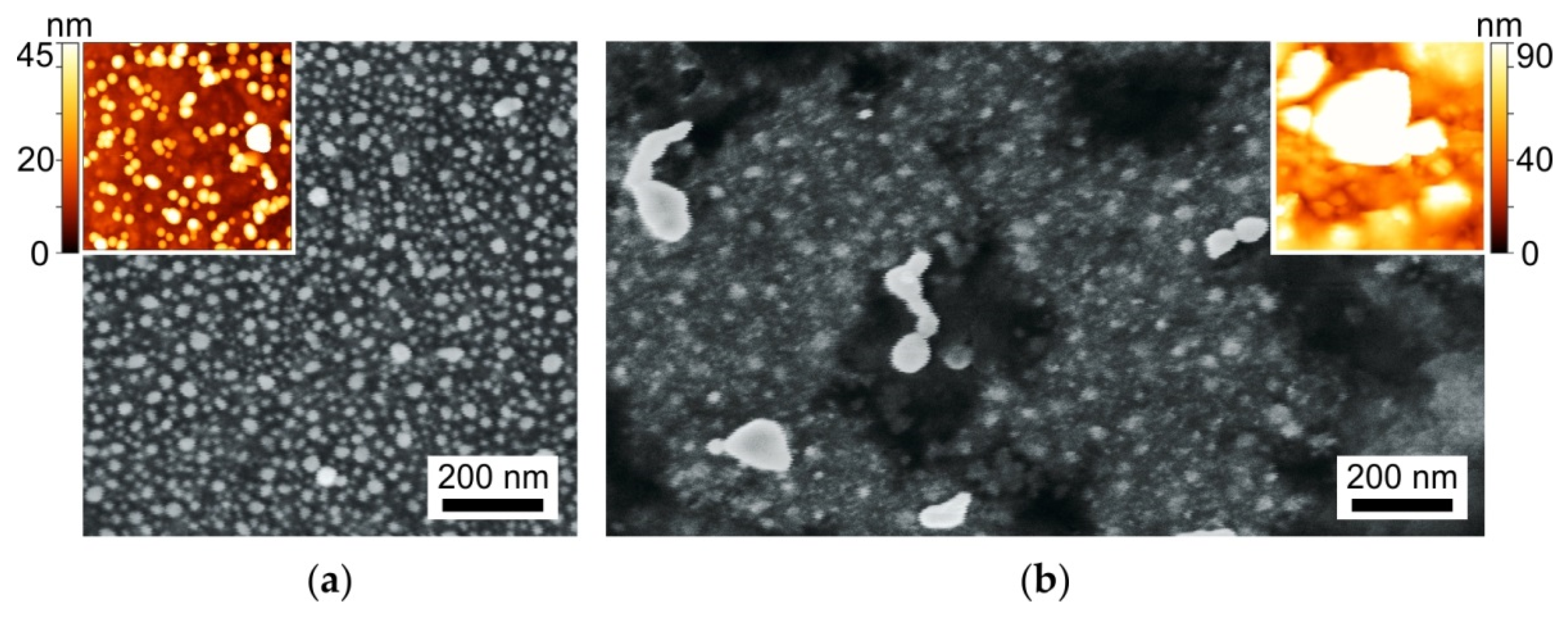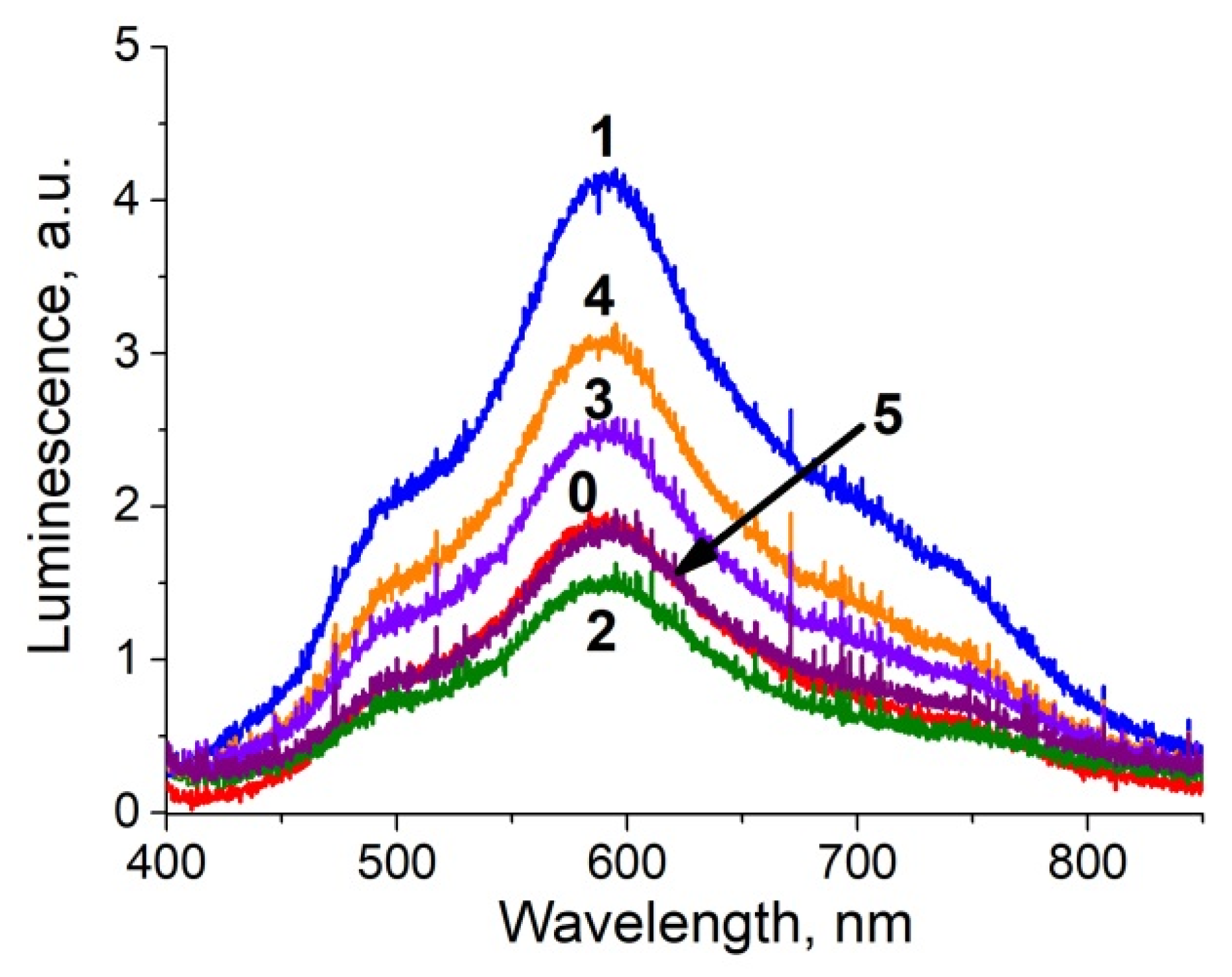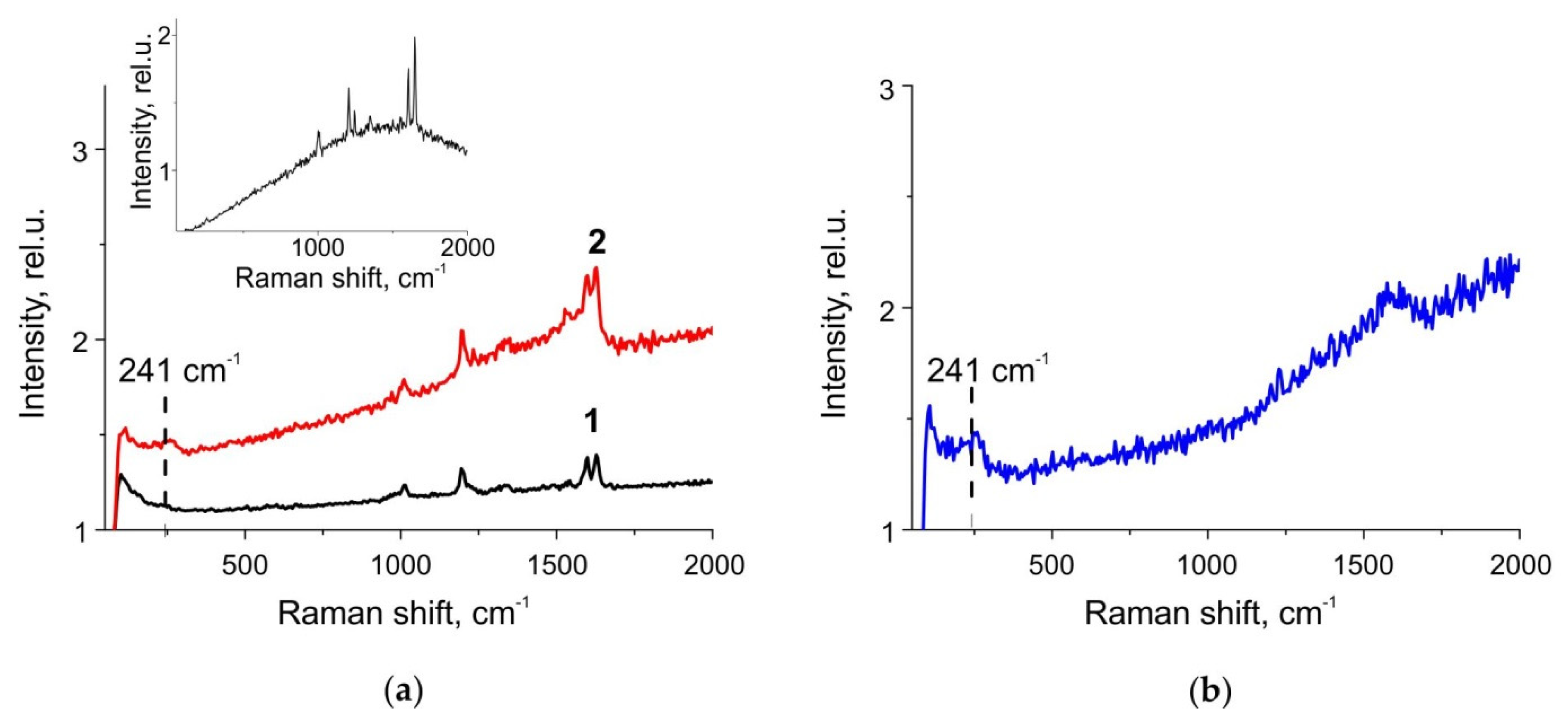Stable in Biocompatible Buffers Silver Nanoisland Films for SERS
Abstract
:1. Introduction
2. Materials and Methods
3. Results and Discussion
3.1. Silver Nanoislands and Nanoparticles Behavior
3.2. Influence of Buffer Composition
3.3. Chemical Conversions
3.4. Surface Enhanced Raman Scattering
4. Conclusions
Author Contributions
Funding
Institutional Review Board Statement
Informed Consent Statement
Conflicts of Interest
References
- Raschke, G.; Kowarik, S.; Franzl, T.; Sönnichsen, C.; Klar, T.A.; Feldmann, J.; Nichtl, A.; Kürzinger, K. Biomolecular recognition based on single gold nanoparticle light scattering. Nano Lett. 2003, 3, 935–938. [Google Scholar] [CrossRef]
- Zijlstra, P.; Paulo, P.M.R.; Orrit, M. Optical detection of single non-absorbing molecules using the surface plasmon resonance of a gold nanorod. Nat. Nanotechnol. 2012, 7, 379–382. [Google Scholar] [CrossRef] [Green Version]
- Mernagh, D.R.; Janscak, P.; Firman, K.; Kneale, G.G. Protein-Protein and Protein-DNA Interactions in the Type I. Restriction Endonuclease R.EcoR124I. Biol. Chem. 1998, 379, 497–504. [Google Scholar] [CrossRef] [PubMed]
- Kukushkin, V.I.; Astrakhantseva, A.S.; Morozova, E.N. Influence of the Morphology of Metal Nanoparticles Deposited on Surfaces of Silicon Oxide on the Optical Properties of SERS Substrates. Bull. Russ. Acad. Sci. Phys. 2021, 85, 133–140. [Google Scholar] [CrossRef]
- Kneipp, K.; Kneipp, H.; Itzkan, I.; Dasari, R.R.; Feld, M.S. Surface-enhanced Raman scattering and biophysics. J. Phys. Condens. Matter 2002, 14, 202. [Google Scholar] [CrossRef] [Green Version]
- Kukushkin, V.I.; Ivanov, N.M.; Novoseltseva, A.A.; Gambaryan, A.S.; Yaminsky, I.V.; Kopylov, A.M.; Zavyalova, E.G. Highly sensitive detection of influenza virus with SERS aptasensor. PLoS ONE 2019, 14, e0216247. [Google Scholar] [CrossRef] [PubMed] [Green Version]
- Marks, H.; Schechinger, M.; Garza, J.; Locke, A.; Coté, G. Surface enhanced Raman spectroscopy (SERS) for in vitro diagnostic testing at the point of care. Nanophotonics 2017, 6, 681–701. [Google Scholar] [CrossRef]
- Li, H.; Zhao, N.; Wang, Y.; Zou, R.; Yang, Z.; Zhu, C.; Wang, M.; Yu, H. Wafer-scale silver nanoislands with ∼5 nm interstitial gaps for surface-enhanced Raman scattering. Opt. Mater. Express 2020, 10, 3359. [Google Scholar] [CrossRef]
- Khlebtsov, B.N.; Khanadeev, V.A.; Panfilova, E.V.; Bratashov, D.N.; Khlebtsov, N.G. Gold Nanoisland Films as Reproducible SERS Substrates for Highly Sensitive Detection of Fungicides. ACS Appl. Mater. Interfaces 2015, 7, 6518–6529. [Google Scholar] [CrossRef]
- Chokboribal, J.; Vanidshow, W.; Yuwasonth, W.; Chananonnawathorn, C.; Waiwijit, U.; Hincheeranun, W.; Dhanasiwawong, K.; Horprathum, M.; Rattana, T.; Sujinnapram, S.; et al. Annealed plasmonic Ag nanoparticle films for surface enhanced fluorescence substrate. Mater. Today Proc. 2021, 47, 3492–3495. [Google Scholar] [CrossRef]
- Potejanasak, P.; Duangchan, S. Gold Nanoisland Agglomeration upon the Substrate Assisted Chemical Etching Based on Thermal Annealing Process. Crystals 2020, 10, 533. [Google Scholar] [CrossRef]
- Babich, E.; Raskhodchikov, D.; Redkov, A.; Hmima, A.; Nashchekin, A.; Lipovskii, A. Dendritic structures by glass electrolysis: Studies and SERS capability. Curr. Appl. Phys. 2021, 24, 54–59. [Google Scholar] [CrossRef]
- Babich, E.; Kaasik, V.; Redkov, A.; Maurer, T.; Lipovskii, A. SERS-Active Pattern in Silver-Ion-Exchanged Glass Drawn by Infrared Nanosecond Laser. Nanomaterials 2020, 10, 1849. [Google Scholar] [CrossRef]
- Šubr, M.; Petr, M.; Kylián, O.; Kratochvíl, J.; Procházka, M. Large-scale Ag nanoislands stabilized by a magnetron-sputtered polytetrafluoroethylene film as substrates for highly sensitive and reproducible surface-enhanced Raman scattering (SERS). J. Mater. Chem. C 2015, 3, 11478–11485. [Google Scholar] [CrossRef]
- Zhou, L.; Ionescu, R.E. Influence of Saline Buffers over the Stability of High-Annealed Gold Nanoparticles Formed on Coverslips for Biological and Chemosensing Applications. Bioengineering 2020, 7, 68. [Google Scholar] [CrossRef] [PubMed]
- Zhurikhina, V.V.; Brunkov, P.N.; Melehin, V.G.; Kaplas, T.; Svirko, Y.; Rutckaia, V.V.; Lipovskii, A.A. Self-assembled silver nanoislands formed on glass surface via out-diffusion for multiple usages in SERS applications. Nanoscale Res. Lett. 2012, 7, 1–5. [Google Scholar] [CrossRef] [Green Version]
- Agar Scientific. Available online: http://www.agarscientific.com/microscope-slides.html (accessed on 11 September 2021).
- Liñares, J.; Sotelo, D.; Lipovskii, A.A.; Zhurihina, V.V.; Tagantsev, D.K.; Turunen, J. New glasses for graded-index optics: Influence of non-linear diffusion in the formation of optical microstructures. Opt. Mater. (Amst) 2000, 14, 145–153. [Google Scholar] [CrossRef]
- Chervinskii, S.; Sevriuk, V.; Reduto, I.; Lipovskii, A. Formation and 2D-patterning of silver nanoisland film using thermal poling and out-diffusion from glass. J. Appl. Phys. 2013, 114, 224301. [Google Scholar] [CrossRef]
- Eichelbaum, M.; Rademann, K.; Hoell, A.; Tatchev, D.M.; Weigel, W.; Stößer, R.; Pacchioni, G. Photoluminescence of atomic gold and silver particles in soda-lime silicate glasses. Nanotechnology 2008, 19, 135701. [Google Scholar] [CrossRef]
- Nedyalkov, N.; Dikovska, A.; Koleva, M.; Stankova, N.; Nikov, R.; Borisova, E.; Genova, T.; Aleksandrov, L.; Iordanova, R.; Terakawa, M. Luminescence properties of laser-induced silver clusters in borosilicate glass. Opt. Mater. (Amst) 2020, 100, 109618. [Google Scholar] [CrossRef]
- Yang, W.; Hulteen, J.; Schatz, G.C.; Van Duyne, R.P. A surface-enhanced hyper-Raman and surface-enhanced Raman scattering study of trans -1,2-bis(4-pyridyl)ethylene adsorbed onto silver film over nanosphere electrodes. Vibrational assignments: Experiment and theory. J. Chem. Phys. 1996, 104, 4313–4323. [Google Scholar] [CrossRef]
- Blackie, E.J.; Le Ru, E.C.; Etchegoin, P.G. Single-molecule surface-enhanced raman spectroscopy of nonresonant molecules. J. Am. Chem. Soc. 2009, 131, 14466–14472. [Google Scholar] [CrossRef] [PubMed]
- Brewer, A.Y.; Friscic, T.; Day, G.M.; Overvoorde, L.M.; Parker, J.E.; Richardson, C.N.; Clarke, S.M. The monolayer structure of 1,2-bis(4-pyridyl)ethylene physisorbed on a graphite surface. Mol. Phys. 2013, 111, 73–79. [Google Scholar] [CrossRef]
- Mogensen, K.B.; Kneipp, K. Size-Dependent Shifts of Plasmon Resonance in Silver Nanoparticle Films Using Controlled Dissolution: Monitoring the Onset of Surface Screening Effects. J. Phys. Chem. C 2014, 118, 28075–28083. [Google Scholar] [CrossRef]
- El Hamzaoui, H.; Capoen, B.; Razdobreev, I.; Bouazaoui, M. In situ growth of luminescent silver nanoclusters inside bulk sol-gel silica glasses. Mater. Res. Express 2017, 4, 076201. [Google Scholar] [CrossRef]
- Cattaruzza, E.; Mardegan, M.; Trave, E.; Battaglin, G.; Calvelli, P.; Enrichi, F.; Gonella, F. Modifications in silver-doped silicate glasses induced by ns laser beams. Appl. Surf. Sci. 2011, 257, 5434–5438. [Google Scholar] [CrossRef]
- Borsella, E.; Cattaruzza, E.; De Marchi, G.; Gonella, F.; Mattei, G.; Mazzoldi, P.; Quaranta, A.; Battaglin, G.; Polloni, R. Synthesis of silver clusters in silica-based glasses for optoelectronics applications. J. Non-Cryst. Solids 1999, 245, 122–128. [Google Scholar] [CrossRef]
- Reduto, I.; Babich, E.; Zolotovskaya, S.; Abdolvand, A.; Lipovskii, A.; Zhurikhina, V. Controlled metallization of ion-exchanged glasses by thermal poling. J. Phys. Condens. Matter 2021. [Google Scholar] [CrossRef]
- Charlton, S.R.; Parkhurst, D.L. Modules based on the geochemical model PHREEQC for use in scripting and programming languages. Comput. Geosci. 2011, 37, 1653–1663. [Google Scholar] [CrossRef]
- Pargar, F.; Koleva, D. Polarization Behaviour of Silver in Model Solutions. Int. J. Struct. Civ. Eng. Res. 2017, 172–176. [Google Scholar] [CrossRef]
- Nehal, M.E.F.; Bouzidi, A.; Nakrela, A.; Miloua, R.; Medles, M.; Desfeux, R.; Blach, J.-F.; Simon, P.; Huvé, M. Synthesis and characterization of antireflective Ag@AgCl nanocomposite thin films. Optik 2020, 224, 165568. [Google Scholar] [CrossRef]
- Marton, M.; Vojs, M.; Zdravecká, E.; Himmerlich, M.; Haensel, T.; Krischok, S.; Kotlár, M.; Michniak, P.; Veselý, M.; Redhammer, R. Raman Spectroscopy of Amorphous Carbon Prepared by Pulsed Arc Discharge in Various Gas Mixtures. J. Spectrosc. 2013, 2013, 467079. [Google Scholar] [CrossRef]








| SiO2 | Al2O3 | Na2O | K2O | MgO | CaO | Others |
|---|---|---|---|---|---|---|
| 72.2 | 1.2 | 14.3 | 1.2 | 4.3 | 6.4 | 0.33 |
| Buffer Number (#) | Name | Composition 1 | Active Ions |
|---|---|---|---|
| 1 | PBS | NaCl 137 mM, Na2HPO4/KH2PO4, [PO4] = 12 mM, pH 7.4 | Na+, Cl− |
| 2 | water (diluted PBS) | NaCl 0.137 mM, Na2HPO4/KH2PO4, [PO4] = 0.012 mM, pH 7.1 | H+, OH− |
| 3 | PB⋅NaClO4 | NaClO4 137 mM, Na2HPO4/KH2PO4, [PO4] = 12 mM, pH 7.4 | Na+ |
| 4 | PB⋅TMAC | N(CH3)4Cl 137 mM, Na2HPO4/KH2PO4, [PO4] = 12 mM, pH 7.4 | Cl− |
| 5 | acidic phosphate buffer | H3PO4/Na2HPO4, [PO4] = 12 mM, pH 3.3 | H+ |
| Change after Exposure to the Buffer | Buffer | ||||
|---|---|---|---|---|---|
| PBS | Diluted PBS | PB⋅NaClO4 | PB⋅TMAC | Acidic Buffer | |
| Degradation of “surface” NPs | − | − | − | + | − |
| optical absorption input 1 | |||||
| Degradation of “volume” NPs | + | − | − | − | − |
| optical absorption input | |||||
| Visible discoloration | + | − | − | + | − |
| and tarnishing of the film | |||||
| Overall spectral changes in 330–830 nm range, peak, |ΔD24h| 2 | Strong 0.35 | Weak | Weak | Strong | Strong |
| 0.04 | 0.02 | 0.22 | 0.2 | ||
| Change in NPs SPR peak, |ΔD24h|max | Decrease | Shape change | Shape change | Decrease | Decrease |
| 0.17 | 0.04 | 0.04 | 0.22 | 0.19 | |
| Change in red (600–900 nm) absorption | Strong decrease | Very small decrease | Very small | Small | Decrease |
| shoulder 3 | decrease | decrease | |||
| Change in luminescence at 590 nm | Strong increase | Small | Small | Strong | Very small |
| 2231 | decrease | increase | increase | decrease | |
| −400 | 563 | 1172 | −75 | ||
| Silver concentration in buffer | 3.26 | 2.8 | 0.86 | 4.99 | not |
| after 22–24 h of the exposure, μM | measured | ||||
Publisher’s Note: MDPI stays neutral with regard to jurisdictional claims in published maps and institutional affiliations. |
© 2021 by the authors. Licensee MDPI, Basel, Switzerland. This article is an open access article distributed under the terms and conditions of the Creative Commons Attribution (CC BY) license (https://creativecommons.org/licenses/by/4.0/).
Share and Cite
Skvortsov, A.; Babich, E.; Redkov, A.; Lipovskii, A.; Zhurikhina, V. Stable in Biocompatible Buffers Silver Nanoisland Films for SERS. Biosensors 2021, 11, 448. https://doi.org/10.3390/bios11110448
Skvortsov A, Babich E, Redkov A, Lipovskii A, Zhurikhina V. Stable in Biocompatible Buffers Silver Nanoisland Films for SERS. Biosensors. 2021; 11(11):448. https://doi.org/10.3390/bios11110448
Chicago/Turabian StyleSkvortsov, Alexey, Ekaterina Babich, Alexey Redkov, Andrey Lipovskii, and Valentina Zhurikhina. 2021. "Stable in Biocompatible Buffers Silver Nanoisland Films for SERS" Biosensors 11, no. 11: 448. https://doi.org/10.3390/bios11110448
APA StyleSkvortsov, A., Babich, E., Redkov, A., Lipovskii, A., & Zhurikhina, V. (2021). Stable in Biocompatible Buffers Silver Nanoisland Films for SERS. Biosensors, 11(11), 448. https://doi.org/10.3390/bios11110448




